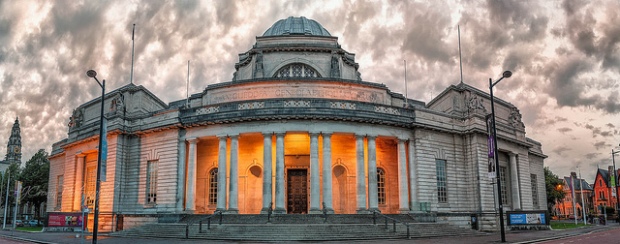In March of this year, our Managing Director, Alan Francis, supported the ambitions of Cardiff Council to make Cardiff a more ‘liveable’ city, in an open letter. Alan pointed out that whilst Cardiff has an enviable reputation as an excellent events city, this does have the drawback of attracting people only for the event itself. This in turn results in short stays in the city, rather than longer city-breaks, where a more meaningful engagement with what Cardiff has to offer could be made.

Popular visitor destination in Cardiff- Cardiff Bay
In his letter, Alan highlighted two key improvements that could propel Cardiff into a different league in terms of quality- a proper international airport with direct transport connections to the inner city, and a cultural heart.
It is to be hoped that the renewed momentum at Cardiff Airport with a new Chair and the support of the Welsh Government will begin to bear fruit, which would mean at least the transport part of the jigsaw is slotting into place.
However, the question of a cultural heart is a different and potentially more challenging matter, and one where Cardiff’s success as a sporting venue is a double-edged sword. The most frequent and traditional major sporting events which come to Cardiff revolve around rugby. The Six Nations has become a global brand, and on one hand, the Six Nations rugby weekends are fantastic festivals of camaraderie, passion and entertainment which attract huge crowds to the city.

Crowds gather for sporting events on Westgate Street, Cardiff, outside the Principality Stadium
On the other hand though, this kind of event can become mistaken for Cardiff’s prevailing culture, overshadowing other potential reasons for visiting. Not only this, but there are only two or three such rugby weekends in a year, plus the occasional Ashes, or cricket event- what sustains the city for the rest of the year?
This is how a more rounded and considered approach to culture could pay dividends.
The so-called ‘Bilbao effect’ is an oft-quoted and frequently misunderstood phenomena. In essence, it refers to the case study of Bilbao- a medium sized, Basque, industrial port city in the north of Spain- which has managed to reinvent itself around the construction of a remarkable architectural centrepiece; the new Guggenheim Museum, designed by Frank Gehry. Two decades after the similarly revitalising Pompidou Centre opened in Paris, the example of Bilbao shows how an imaginatively designed cultural heart commissioned by an energetic mayor can help turn a city around.

The Guggenheim Museum by Frank Gehry, in Bilbao, Spain.
A report in the Economist from 2013, noted that:
“Visitors’ spending in Bilbao in the first three years after the museum opened raised over €100m ($110m) in taxes for the regional government, enough to recoup the construction costs and leave something over”,
illustrating the financial benefits that such an investment in culture can bring. Unsurprisingly, the Economist report concluded that,
“Other cities without historic cultural centres now look to Bilbao as a model for what vision and imagination can achieve.”
It could be argued that Cardiff has some interesting advantages over a place like Bilbao when it comes to cultural re-invention. Firstly, Cardiff already attracts a significant number of tourist visitors. And secondly, Cardiff has its own internationally renowned art collection- the very thing that had to be ‘bussed-in’ by the Guggenheim to Bilbao in order to fill the halls of their shiny new museum.
The art collection of the National Museum of Wales, which owes an enormous debt of gratitude to the Davies sisters, is exceptional. Gwendoline and Margaret Davies were the granddaughters of the fabulously wealthy Welsh industrialist David Davies, and they collated one of the “great British art collections of the 20th century”, the entirety of which (a total of 260 works) was bequeathed to the National Museum of Wales. This outstanding collection, including impressionist masterpieces by Monet and romanticist works by Turner, forms the nucleus of the greater collection belonging to the museum. This really is Cardiff’s secret cultural weapon- the art gallery holding one of the greatest collections of art in the UK, hidden away on the first floor.

National Museum of Wales, Cardiff
Indeed, it is worth noting that the same Economist report that praised the regeneration of Bilbao admits that “the collection on display is modest”. And we are all too familiar with proposed projects elsewhere in the world, where the cultural heritage perhaps does not match the architectural ambition; stunning yet empty museums, such as the Ordos Art Gallery in China which owns no collections, and has nothing to display.
As Alan pointed out in his letter, our National Museum is first class, but it suffers because it is trying to be both a history museum and an art gallery, rather than giving both collections the space and independence they deserve. Here then, is the opportunity to position the second piece of the jigsaw- the cultural heart- mentioned in Alan’s letter. As he noted, in order for us to get the kind of city that may entice people to stay for more than one night, we need to:
a) Change the National Museum into the National Gallery of Art, displaying its remarkable collection to full effect;
b) Move the Natural History exhibits into a new National Gallery of Science in the city centre, or perhaps in the Bay;
c) Create a new National Museum of Contemporary Art in the city centre.
Whereas Bilbao needed an injection of cultural exhibits, Alan’s letter set out a manifesto for building on the cultural assets that Cardiff already has, to lift the city into a different league. Not only great for rugby and shopping, but a place which has historical and cultural depth and rewards a longer stay- something we like to think we knew already.